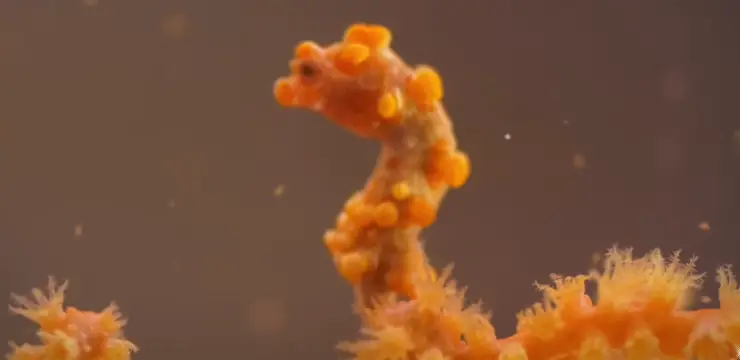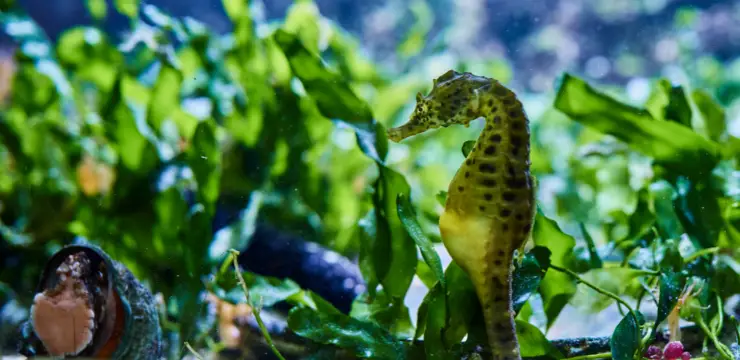Did you see a red seahorse turn ocean blue and almost disappear? Yes, it’s possible. Seahorses can change color to camouflage themselves from predators and catch their prey.
While these are the most well-known reasons for their ability to change color, there are several other reasons why seahorses can do this.
This article will discuss more compelling reasons why seahorses can change color and how they do so!
Can Seahorses Change Color? Here is Why?
Seahorses can change color for a few reasons, but the most common one is for camouflage. If seahorses can match the colors around them, predators are less likely to be seen and eaten.
In addition, their coloration changes when they are seeking out prey. When the color around them is lighter, they will become darker to better camouflage themselves and surprise their prey.
On the other hand, when the background is darker, they will lighten their color to avoid being seen.
Seahorses can also change color to communicate with each other. For example, when a male and female seahorse are ready to mate, they will often switch to similar colors. This helps them to find each other in the vast ocean.
Additionally, seahorses can also change color to regulate their body temperature. By changing the amount of black or white pigment in their skin, seahorses can absorb more or less heat from the sun. This helps them to stay comfortable in different temperatures.
How Do Seahorses Change Color?
Seahorses called the master of camouflage. They have two types of cells in their skin:
- Chromatophores: Chromatophores are pigment cells that contain melanin, a dark pigment that absorbs light.
- Iridophores: Iridophores are reflective cells that contain guanine, a protein that reflects light.
By expanding or contracting these cells, seahorses can change the way light is reflected off their skin, allowing them to match their background and avoid being seen.
Seahorses can also use their muscles to control the amount of pigment showing, allowing them to produce a wide range of colors. Some seahorses can even produce a glowing effect!
As a result, they can survive in the open ocean, where they would otherwise be easy prey.
Can Baby Seahorses Change Color?
Yes, baby seahorses can change color, just like adult seahorses. They typically start changing color within the first few days of their lives.

However, it’s important to note that baby seahorses are not as good at camouflage as adults. This is because their chromatophores have not fully developed yet.
Baby seahorses are at a greater risk of being seen by predators because they’re small and vulnerable. So, they must be super careful about changing their color.
Do All Seahorses Change Color?
Unfortunately, no. Not all seahorses change color. In fact, most seahorses only change color a few times throughout their lives.
However, some species of seahorses can change color much more frequently. For example, the Spotted seahorse can change color up to 30 times in a single day!
How Many Colors Can Seahorses Transform Into?
Seahorses can transform into various colors, depending on their species. Some seahorses can only produce a few colors, while others can produce hundreds!
The most common colors that seahorses can change into are brown, green, and yellow. However, some seahorses can also transform red, grey, orange, pink, blue, and even purple!
Is It Risky For Seahorses To Change Their Color?
Yes, it can be. Seahorses that try to match colors that are very different from their natural coloration can risk being seen by predators.
In addition, seahorses that change their color too frequently can damage their skin. This is because the process of expanding and contracting their chromatophores can be pressuring on their muscles.
Therefore, seahorses must be careful about when they change their color. While the ability to change color is a fantastic adaptation, it should be used sparingly to avoid potential risks.
Why Do Seahorses Turn Black?
Seahorses can turn black mainly because of stress. When they are stressed, their bodies produce more melanin, which can make them appear darker.
In addition, some seahorses can turn black as a way to absorb more heat from the sun. By absorbing more heat, they can stay warm in colder waters.
Why Do Seahorses Turn Fade?
Seahorses can turn pale or fade for a few reasons. The main reason is poor water quality. Here seahorses’ colors can fade, and chromatophores can shrink in response to high concentrations of nitrogenous wastes in water (such as ammonia, nitrite, or nitrate).
Another reason is that they are trying to match the lighter colors around them. This helps them to avoid being seen by predators.
Additionally, the indication of seahorse health is the pallor of their skin. When they are ill or close to death, their muscles become inactive, allowing less pigment to show.
Are Seahorses The Only Animals That Can Change Color?
While seahorses are well-known for their ability to change color, they are not the only animals that can do so. Many animals can adjust their skin tone to blend in with their surroundings better.
Octopuses, for example, are experts at camouflage and can match the colors and patterns of their environment in just a matter of seconds.
Chameleons are another well-known example of animals that can change color, though they typically use this ability to communicate with other chameleons rather than blend in.
Regardless, it’s clear that the ability to change color is not unique to seahorses. Instead, it’s a skill that is shared by many different types of animals.
Conclusion
The ability of seahorses to change color is an essential factor in their survival. It allows them to better blend in with their surroundings and avoid being seen by predators. Even to get their food, this color transformation technique is super helpful.
However, this ability can also be risky if not used carefully. Baby seahorses, in particular, must be extra careful about changing their color because they are more vulnerable than adults. But overall, the ability to change color is vital to making seahorses unique and special.


7 thoughts on “Can Seahorses Change Color? Amazing Seahorse Fact!”